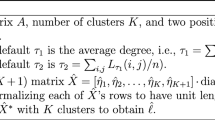Abstract
We study the vertex classification problem on a graph whose vertices are in \(k\ (k\ge 2)\) different communities, edges are only allowed between distinct communities, and the number of vertices in different communities are not necessarily equal. The observation is a weighted adjacency matrix, perturbed by a scalar multiple of the Gaussian Orthogonal Ensemble (GOE), or Gaussian Unitary Ensemble (GUE) matrix. For the exact recovery of the maximum likelihood estimation (MLE) with various weighted adjacency matrices, we prove sharp thresholds of the intensity \(\sigma \) of the Gaussian perturbation. Roughly speaking, when \(\sigma \) is below (resp. above) the threshold, exact recovery of MLE occurs with probability tending to 1 (resp. 0) as the size of the graph goes to infinity. These weighted adjacency matrices may be considered as natural models for the electric network. Surprisingly, these thresholds of \(\sigma \) do not depend on whether the sample space for MLE is restricted to such classifications that the number of vertices in each group is equal to the true value. In contrast to the \({{\mathbb {Z}}}_2\)-synchronization, a new complex version of the semi-definite programming (SDP) is designed to efficiently implement the community detection problem when the number of communities k is greater than 2, and a common region (independent of k) for \(\sigma \) such that SDP exactly recovers the true classification is obtained.
Similar content being viewed by others
References
Abbe, E.: Community detection and stochastic block models: recent developments. J. Mach. Learn. Res. 18, 1–86 (2018)
Abbe, E., Sandon, C.: Community detection in general stochastic block models:fundamental limits and efficient recovery algorithms. In: 2015 IEEE 56th Annual Symposium on Foundations of Computer Science, pp. 670–688 (2015)
Abbe, E., Bandeira, A.S., Hall, G.: Exact recovery in the stochastic block model. IEEE Trans. Inf. Theory 62, 471–487 (2016)
Chen, J., Yuan, B.: Detecting functional modules in the yeast protein-protein interaction network. Bioinformatics 22, 2283–2290 (2006)
Chin, P., Rao, A., Vu, V.: Stochastic block model and community detection in the sparse graphs: a spectral algorithm with optimal rate of recovery. Proc. Mach. Learn. Res. 40, 391–423 (2015)
Girvan, M., Newman, M.E.J.: Community structure in social and biological networks. Proc. Natl. Acad. Sci. 99, 7821–7826 (2002)
Hajek, B., Wu, Y., Xu, J.: Achieving exact cluster recovery threshold via semidefinite programming. IEEE Trans. Inf. Theory 62, 2788–2797 (2016)
Holland, P., Laskey, K.B., Leinhardt, S.: Stochastic blockmodels: first steps. Soc. Netw. 5, 109–137 (1983)
Hsing, T., Hüsler, J., Reiss, R.-D.: The extremes of a triangular array of normal random variables. Ann. Appl. Probab. 6, 671–686 (1996)
Javanmard, A., Montanari, A., Ricci-Tersenghi, F.: Performance of a community detection algorithm based on semidefinite programming. J. Phys. 699, 012015 (2016)
Javanmard, A., Montanari, A., Ricci-Tersenghi, F.: Phase transitions in semidefinite relaxations. Proc. Natl. Acad. Sci. 113(16), E2218–2223 (2016)
Kim, C., Bandeira, A., Goemans, M.: Community detection in hypergraphs, spiked tensor models, and sum-of-squares. In: 2017 12th International Conference on Sampling Theory and Applications, pp. 124–128 (2017)
Li, Z.: Exact recovery of community detection in k-community gaussian mixture models (2020)
Marcotte, E.M., Pellegrini, M., Ng, H.L., Rice, D.W., Yeates, T.O., Eisenberg, D.: Detecting protein function and protein-protein interactions from genome sequences. Science 285, 751–753 (1999)
Massoulié, L.: Community detection thresholds and the weak Ramanujan property. In: Proceedings of the 46th Annual ACM Symposium on Theory of Computing, pp. 694–703 (2014)
Montanari, A., Sen, S.: Semidefinite programs on sparse random graphs and their application to community detection. In: Proceedings of the Forty-Eighth Annual ACM Symposium on Theory of Computing, pp. 814–827 (2016)
Moore, C.: The computer science and physics of community detection: landscapes, phase transitions, and hardness (2017)
Mossel, E., Neeman, J., Sly, A.: A proof of the blockmodel threshold conjecture. Combinatorica 38, 665–708 (2018)
Newman, M.E.J., Watts, D.J., Strogatz, S.H.: Random graph models of social networks. Proc. Natl. Acad. Sci. 99, 2566–2572 (2002)
Tracy, C.A., Widom, H.: Distribution functions for largest eigenvalues and their applications. Proc. Int. Congr. Math. I, 587–596 (2002)
Acknowledgements
ZL’s research is supported by National Science Foundation grant 1608896 and Simons Foundation Grant 638143.
Author information
Authors and Affiliations
Corresponding author
Additional information
Communicated by Federico Ricci-Tersenghi.
Publisher's Note
Springer Nature remains neutral with regard to jurisdictional claims in published maps and institutional affiliations.
Appendix A: Proof of Lemma 3.9
Appendix A: Proof of Lemma 3.9
It is known that for a standard Gaussian random variable \(G_i\) and \(x>0\),
Let \(G_1,\ldots , G_N\) be N standard Gaussian random variables. Then by (7.31) we have
If we further assume that \(G_i\)’s are independent, then
By (7.31) we obtain
When (3.22) holds, we have
Then the lemma follows.
Rights and permissions
About this article
Cite this article
Li, Z. Exact Recovery of Community Detection in k-Partite Graph Models with Applications to Learning Electric Potentials in Electric Networks. J Stat Phys 182, 6 (2021). https://doi.org/10.1007/s10955-020-02690-1
Received:
Accepted:
Published:
DOI: https://doi.org/10.1007/s10955-020-02690-1




